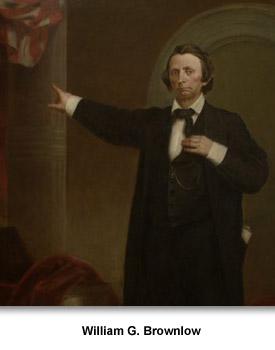Civil War and Reconstruction
Radical Republicans
In January 1865, more than 500 Unionists met in Nashville. They began the process of Tennessee rejoining the Union. In April, they elected Radical Republican William G. Brownlow as governor.
Brownlow and other Tennessee Radical Republicans allied themselves with Radical Republicans in the United States Congress. They wanted strict measures for punishing all former Confederates. They also supported expanding African Americans’ rights. Radical Republicans in Tennessee and Congress often disagreed with President Andrew Johnson.
Governor Brownlow wanted to restore Tennessee to the Union. The state legislature ratified the 13th Amendment to the United States Constitution which outlawed slavery.
State lawmakers also needed to pass the 14th Amendment which granted African Americans citizenship rights. This amendment was quite controversial. Many white Tennesseans were divided on this issue. President Johnson also opposed the amendment.
Some of the Tennessee legislators decided to refuse to attend the session when they were supposed to vote on the 14th Amendment. They hoped there would not be a quorum—a number of legislators required to be present in order for a vote to count.
Governor Brownlow found out about their plan, and he had two of the legislators arrested and imprisoned in the state capitol building. They were counted as being present even though they did not vote. The legislature did vote in favor of ratifying the 14th Amendment. Tennessee became the first Confederate state to re-enter the United States.
Radical Republicans favored reforms and worked to expand the role of state government. They passed laws that created a state school system, fought the Ku Klux Klan, and supported improvements to the state infrastructure like railroads.
In order to pay for these measures, the Radical Republicans greatly increased state taxes. This was very unpopular.
Picture Credits:
- Print entitled, “Passage of the amendment of the Constitution prohibiting slavery.” Printed on the border are the words, “From a sketch made at the time.” This drawing was originally published in 1890 in the book, Freedom triumphant: the fourth period of war of the rebellion, from September 1864, to its close. New York Public Library
- Portrait oil painting of William G. Brownlow. This full sized portrait was created in 1866 by George Dury and carries the inscription, “The Fighting Parson.” Brownlow is shown standing next to a column. Tennessee State Museum Collection, 76.13
- Print entitled, “Reading the Emancipation Proclamation.” The drawing depicts the reading of the Emancipation Proclamation to slaves in their cabin by the military. An sketch of Abraham Lincoln is also included near the bottom of the print. Tennessee State Museum Collection, 79.59
Civil War and Reconstruction >> Reconstruction >> World of Politics >> Radical Republicans



 Sponsored by: National Endowment for the Humanities
Sponsored by: National Endowment for the Humanities